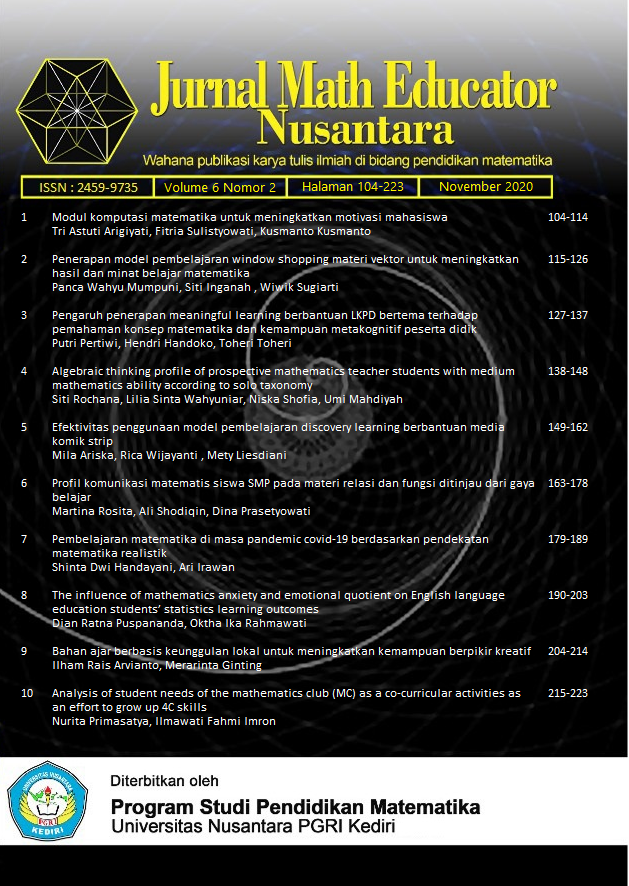Penerapan model pembelajaran window shopping materi vektor untuk meningkatkan hasil dan minat belajar matematika
DOI:
https://doi.org/10.29407/jmen.v6i2.12827Keywords:
Window Shopping: vector: Interest: Result, Window Shopping, Interest to learnAbstract
This classroom action research was motivating by the minimal percentage of class classical completeness, so that the difficulty in understanding the material or interest in learning mathematics is still low. Efforts to overcome those problems through new innovations in managing the classroom to increase interest in learning, so that it was expecting to affect better learning outcomes. Classroom management cannot be separated from the learning model applied. Window shopping learning model is one of the factors of the power of interest in learning. The study consisted of two cycles with the same stages, namely planning, implementing, observing, and reflecting. This study shows an increase in interest in learning in the high category with details of Cycle I of 77% and Cycle of 81%. Improve student learning outcomes with criteria of more than 75%. Learning outcomes from the results of data analysis obtained 66% Cycle I and 77% Cycle II. The results showed that the window shopping learning model could increase the interest and learning outcomes of students at SMA Negeri 2 Batu, especially in vector material.
References
Aritonang, K. T. 2008. Minat dan motivasi dalam meningkatkan hasil belajar siswa. Pendidikan Penabur. (10):11–21.
Cahyanti, A. E., H. dan N. 2016. Pengembangan Perangkat Pembelajaran Matematika Pendekatan Saintifik Model Problem Based Learning dan Higher Order Thinking Materi Barisan dan Deret SMK Kelas 10. 2016. Prosiding Semnasdik 2016 Prodi Pend. Matematika FKIP :Gading Pustaka
Firmansyah, D. 2015. Pengaruh strategi pembelajaran dan minat belajar terhadap hasil belajar matematika. Pendiidkan UNSIKA. 3:34–44.
Gani, A. 2015. Pengaruh model pembelajaran dan persepso tentang matematika terhadap minat dan hasil belajar matematika siswa smp negeri di kecamatan salomekko kabupaten bone. Daya Matematis. 3(3):337–343.
Jatmiko, J. 2015. Eksperimen model pembelajaran think-pair-share dengan modul(TPS-M) terhadap prestasi belajar matematika ditinjau dari minat belajar. Jurnal Ilmiah Pendidikan Matematika, 3(2): 417-426. http://doi.org/10.25273/jipm.v3i2.511
Kurdi, M. 2017. Window shopping : model pembelajaran yang unik dan menarik. Jurnal Lingkar Widyaiswara. (3):27–34.
Lindawati, S. 2017. Melalui strategi pembelajaran react pada siswa kelas xi ipa3. Indonesian Digital Journal of Mathematics and Education. 4:410–420.
Mailili, S. dan W. H. 2020. Pengaruh minat belajar dan motivasi belajar siswa kelas vii smpn 4 sigi terhadap hasil belajar matematika. Pendidikan dan Pembelajaran. 3(1):53–60.
Munaka, F., dkk. 2009. Meningkatkan kemampuan siswa menyelesaikan soal kontekstual melalui cooperative learning di kelas viii smp negeri 2 pedamaran oki. Pendidikan Matematika. 3:47–60.
Ra’is, E. W. 2014. Pengaruh Minat Belajar, Cara Belajar, dan Kreativitas Guru dalam Mengajar Terhadap Hasil Belajar IPS Terpadu Siswa Kelas VIII SMP Islam Terpadu Fitrah Insani Bandar Lampung Tahun Ajaran 2013/2014. Universitas Lampung.
Salama, F. S., Inganah, S., & Sugiarti, W. (2019). Penggunaan model problem based learning untuk meningkatkan aktivitas dan hasil belajar pada materi vektor. Jurnal Math Educator Nusantara: Wahana Publikasi Karya Tulis Ilmiah Di Bidang Pendidikan Matematika, 5(01), 51-58. https://doi.org/10.29407/jmen.v5i01.12815
Sirait, E. D. 2016. Pengaruh minat belajar terhadap prestasi belajar matematika. Formatif Ilmiah Pendidikan MIPA. 6(1):35–43.
Subadi, T. 2010. Lesson Study berbasis PTK (Penelitian Tindakan Kelas). Surakarta: BP-FKIP UMS.
Suprapto. 2017. Window shopping untuk meningkatkan hasil belajar. Jurnal Edumath. 3(2):138–146.
Susilowati, D. 2018. Penelitian tindakan kelas (ptk) solusi alternatif problematika pembelajaran. Edunomika. 2(1):36–46.
wiwik sugiarti. 2018. Peningkatan Aktivitas dan Hasil Belajar Invers Fungsi dengan Media Papan Adventure. Inovasi dalam Pengajaran dan Pembelajaran Matematika. 2018. seminar nasional pendidikan matematika
Downloads
Published
Issue
Section
License
Authors who publish with this journal agree to the following terms:
- Copyright on any article is retained by the author(s).
- The author grants the journal, the right of first publication with the work simultaneously licensed under a Creative Commons Attribution License that allows others to share the work with an acknowledgment of the work’s authorship and initial publication in this journal.
- Authors are able to enter into separate, additional contractual arrangements for the non-exclusive distribution of the journal’s published version of the work (e.g., post it to an institutional repository or publish it in a book), with an acknowledgment of its initial publication in this journal.
- Authors are permitted and encouraged to post their work online (e.g., in institutional repositories or on their website) prior to and during the submission process, as it can lead to productive exchanges, as well as earlier and greater citation of published work.
- The article and any associated published material is distributed under the Creative Commons Attribution-ShareAlike 4.0 International License
















